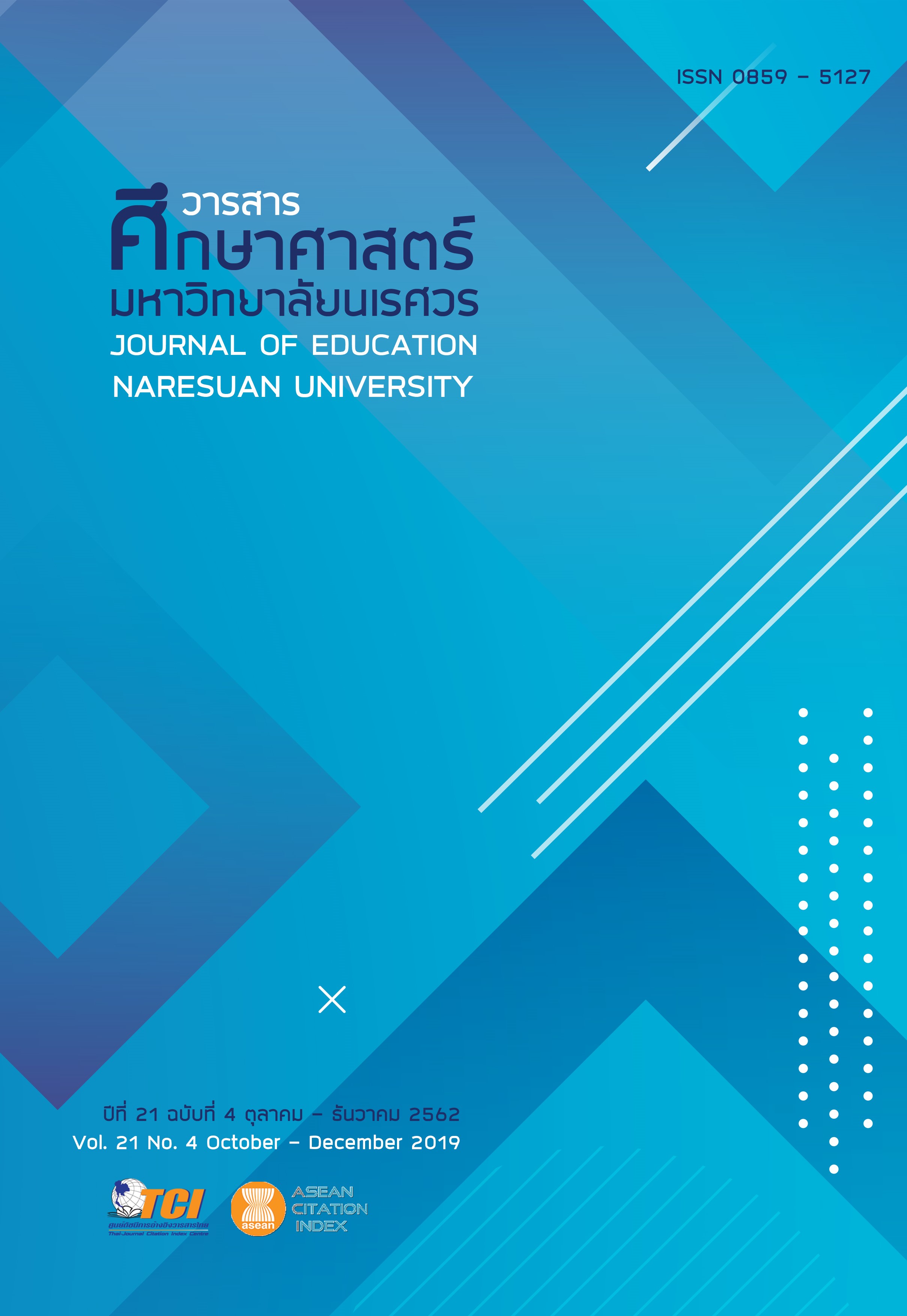การพัฒนาบทเรียนคอมพิวเตอร์ช่วยสอนโดยใช้ขั้นตอนการสอนของกาเย่ เรื่อง เพศศึกษา สำหรับนักเรียนชั้นมัธยมศึกษาปีที่ 2 (THE DEVELOPMENT OF COMPUTER-ASSISTED INSTRUCTION BY USING THE GAGNE’S NINE EVENTS OF INSTRUCTION ON SEX EDUCATION FOR MATHAYOMSUKSA 2 STUDENTS)
Main Article Content
Abstract
การวิจัยครั้งนี้มีวัตถุประสงค์ คือ 1) เพื่อพัฒนาบทเรียนคอมพิวเตอร์ช่วยสอนโดยใช้ขั้นตอนการสอนของกาเย่ เรื่อง เพศศึกษา สำหรับนักเรียนชั้นมัธยมศึกษาปีที่ 2 ให้มีประสิทธิภาพตามเกณฑ์ E1/E2 เท่ากับ 85/85 2) เพื่อเปรียบเทียบผลสัมฤทธิ์ทางการเรียน ก่อนเรียนและหลังเรียน ด้วยบทเรียนคอมพิวเตอร์ช่วยสอน เรื่อง เพศศึกษา สำหรับนักเรียนชั้นมัธยมศึกษาปีที่ 2 3) เพื่อศึกษาความพึงพอใจของนักเรียนที่มีต่อบทเรียนคอมพิวเตอร์ช่วยสอน เรื่อง เพศศึกษา การดำเนินการวิจัยครั้งนี้ผู้วิจัยได้ศึกษาเอกสารและงานวิจัยที่เกี่ยวข้อง เพื่อนำไปกำหนดต้นแบบในการออกแบบบทเรียนคอมพิวเตอร์ช่วยสอน โดยการทดลองใช้กับกลุ่มตัวอย่าง คือนักเรียนชั้นมัธยมศึกษาปีที่ 2 โรงเรียนปรีชานุศาสน์ จำนวน 30 คน โดยวิธีการสุ่มแบบกลุ่ม และวิเคราะห์ข้อมูล ค่าร้อยละ ค่าเฉลี่ย ค่าความเบี่ยงเบนมาตรฐาน การทดสอบประสิทธิภาพ (E1/ E2) และ t-test ผลการวิจัย พบว่า 1) บทเรียนคอมพิวเตอร์ช่วยสอน เรื่อง เพศศึกษา ได้ผลการทดสอบประสิทธิภาพตามเกณฑ์ E1/E2 เท่ากับ 86.44/87.22 ซึ่งเป็นไปตามเกณฑ์ที่กำหนดไว้ 2) ผลการเปรียบเทียบผลสัมฤทธิ์ทางการเรียน ก่อนเรียนและหลังเรียน ด้วยบทเรียนคอมพิวเตอร์ช่วยสอนเรื่อง เพศศึกษา สำหรับนักเรียนชั้นมัธยมศึกษาปีที่ 2 สูงกว่าก่อนเรียนอย่างมีนัยสำคัญทางสถิติที่ระดับ .05 3) ความพึงพอใจของนักเรียนชั้นมัธยมศึกษาปีที่ 2 หลังเรียนด้วยบทเรียนคอมพิวเตอร์ช่วยสอน เรื่อง เพศศึกษา อยู่ในระดับมากที่สุด
THE DEVELOPMENT OF COMPUTER-ASSISTED INSTRUCTION BY USING THE GAGNE’S NINE EVENTS OF INSTRUCTION ON SEX EDUCATION FOR MATHAYOMSUKSA 2 STUDENTS
The objectives of this research were 1) to develop the computer-assisted instruction by using the Gagne’s nine events of instruction on sex education for Mathayomsuksa 2 students with the criteria of E1/E2 = 85/85, 2) to compare the achievement before and after study with the computer-assisted instruction on sex education for Mathayomsuksa 2 students, and 3) to study the student’s satisfaction using the computer-assisted instruction on sex education. The methods of this research were that the researched studied relevant documents, principles, theories, for identifying a draft of the computer-assisted phototype. The research samples consisted of 30 students of Mathayomsuksa 2 students, selected by purposive sampling. Data were used to analyze percentage, mean, standard deviation, E1/E2, and t-test. The research results showed that; 1) the constructed computer-assisted instruction on sex education was efficient according to the set criteria E1/E2 = 86.44/87.22, 2) post-test achievement after studied by the computer-assisted instruction on sex education for Mathayomsuksa 2 students, the mean score was higher than the mean score before studying with the computer-assisted instruction at .05 level of significance, and 3) the student’s satisfaction using the computer-assisted instruction was in the highest level.
Article Details
The owner of the article does not copy or violate any of its copyright. If any copyright infringement occurs or prosecution, in any case, the Editorial Board is not involved in all the rights to the owner of the article to be performed.
References
2. Gange, R. M., & Briggs, L. J. (1979). Principle of instructional design. New York: Holt, Rinchart and Winston.
3. Khemmani, T. (2005). Instructional model: A wide choice. Bangkok: Chulalongkorn University. [in Thai]
4. Khundam, C. (2010). The development of computer-assisted instruction lesson on sex education for prathomsuksa 5 students, Watsaimoon School, Chiang Mai Province (Master thesis). Chiang Mai: Chiang Mai Rajabhat University. [in Thai]
5. Khuhasawanvej, S. (2002). Website development of participatory agro-tourism network in Rayong Province (Independent Study). Chiang Mai: Chiang Mai University. [in Thai]
6. Kulpuang, J., Chauvatcharin, N., & Sirisawatlnthong, C. (2016). A study of biology learning achievement and attitude towards 5ES - Learning Cycle with active learning activities of 12th grade students. Journal of Education Naresuan University, 18(3), 265-275. [in Thai]
7. Laohajaratsang, T. (1998). Computer-assisted instruction. Bangkok: Chulalongkorn University. [in Thai]
8. Lim-aksorn, W. (2003). Education psychology (3rd ed.). Songkhla: Thaksin University. [in Thai]
9. Ministry of Public Health. (2008). Sexual transmitted infection group bureau of AIDS tubercle and sexual transmitted infection. Bangkok: The Agricultural Co-operative Federation of Thailand. [in Thai]
10. Office of the National Education Commission. (1999). National Education Act of B.E. 2542. Bangkok: Prigwhan Graphic. [in Thai]
11. Sa-nguankaew, S. (1991). The development of computer-assisted instruction program. Computer review, 8(78), 173-179. [in Thai]
12. Srifa, P. (2008). E-book talking books. Bangkok: Than Books. [in Thai]
13. Taveerat, P. (2000). Research methodology in behavioral sciences and social sciences (8th ed.). Bangkok: Chulalongkorn University. [in Thai]
14. Vajanasara, K. (2011). Sex 3 years from rape, unintended pregnancy, teenage mothers and assisted reproductive technologies. Bangkok: Duentula Printing House. [in Thai]


